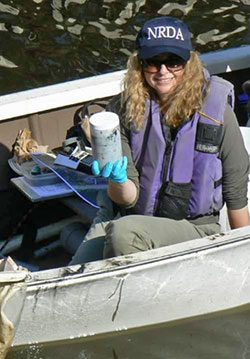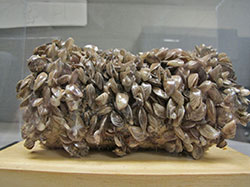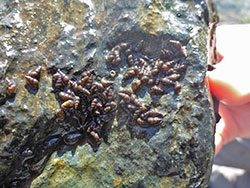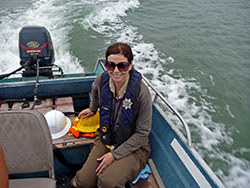Environmental Scientist Angie Montalvo is the aquatic invasive species (AIS) regional coordinator for CDFW’s North Central Region.

Montalvo collecting samples at an oil spill in the Huntington Beach channel

Quagga mussels found in Lake Mead

New Zealand mudsnails found at the Lower Feather River

Montalvo working a spill in the Oakland Harbor
Environmental Scientist Angie Montalvo is the aquatic invasive species (AIS) regional coordinator for CDFW’s North Central Region. Her job is to ensure that invasive species – including quagga and zebra mussels, snails, crabs, clams, fish and aquatic plants – don’t find their way into bodies of water in the region.
Montalvo graduated from the University of California, Davis, with degrees in biological sciences and behavioral psychology. In 1996, she was hired as a scientific aid in CDFW’s Aquatic Bioassessment Laboratory. She was hired as a full-time scientist in 1998 and spent about 15 years working for CDFW’s Office of Spill Prevention and Response (OSPR) on issues involving statewide pollution response, natural resource damage assessment and biological monitoring for macroinvertebrates. Through her work at OSPR she got to know the North Central Region, which helped earn her a promotion in 2013 as the region’s lead AIS coordinator.
What inspired you to become a scientist?
I’ve always been interested in the environment and being outdoors, and I wanted to see positive change for the environment. I always envisioned myself doing a great deal of field work because I enjoy it immensely, and I wanted to be a voice for the natural resources in our state. I developed my interest in AIS while at the Aquatic Bioassessment Lab and while working for OSPR. At OSPR, the focal point was protecting the state’s natural resources from damages due to various pollutants. My current job is somewhat similar, but I am protecting our natural resources from the impacts of introduced AIS.
Tell us more about your role at CDFW?
My work is focused on aquatic biology, mostly dealing with inland, freshwater issues. Currently, there are no waters infested with quagga or zebra mussels within my region, so my focus is on prevention and monitoring. I conduct a lot of monitoring of waterbodies where the risk of introduction and establishment for quagga and zebra mussels falls within the moderate to high range or is unknown. I typically conduct field sampling three to four days per week between late March through November, depending on weather conditions. I monitor for other invasive species as well, including the New Zealand mudsnail, Asian clam and invasive aquatic plants such as hydrilla and Eurasian watermilfoil. Asian clams were introduced into California roughly 40 years ago and have spread from low elevation to high elevation waters. New Zealand mudsnails were introduced into California’s streams about 20 years ago and continue to spread throughout the state.
Another important part of my job is the inspection of watercraft that have entered California from other states. It’s common for people to purchase boats from out of state that have been launched in infested waterbodies. Watercraft entering California are checked while coming across state lines at a California Department of Food and Agriculture inspection station. Food and Ag staff will contact me if they quarantine a watercraft for invasive mussels or other AIS, and I will then reach out to the owner to arrange for an inspection.
Depending on the size of the watercraft, it can take anywhere from 30 minutes to several hours to complete a thorough inspection. I can usually identify quagga and zebra mussels visually. However, if I anticipate a difficult inspection — for example, a houseboat with a lot of small components to search — I reach out to our wildlife officers and their mussel detection dogs. These K9s are trained to detect by scent and can find things that I might not see. I’ve worked with the mussel detection K9s at least half a dozen times and it has worked out very well.
Decontamination of vessels involves using a high-pressure hot washer that can reach water temperatures of more than 160 degrees. I usually conduct follow-up inspections as well. Watercraft aren’t released until there are no remnants of quagga/zebra mussels or other AIS observed.
Why is it important to monitor for aquatic invasive species?
Unfortunately, once you have an infestation – for example, of quagga mussels – you can never eradicate them from a waterbody. They change the water quality and infrastructure of the ecosystem. The infestation results in a build-up or layers of mussels in the ecosystem, which can deplete the water body of nutrients and cause clogging and filtering issues. Not only do invasives alter the ecosystem, but they can affect fisheries, water delivery and recreational opportunities. Trying to address these issues after an infestation can cost many millions of dollars. Prevention, monitoring and education are crucial.
What has been your biggest career accomplishment so far?
I’ve worked on major oil spill incidents like Cosco Busan, the BP Gulf spill and others, which have all been major accomplishments and unique experiences.
Currently, the major accomplishment is there are no waters infested with quagga or zebra mussels within my region. I attribute this success to CDFW’s dedication to practicing the best sampling methodologies, continuing to improve and standardize its statewide program and having a great public outreach and education program.
We’ve had good success with outreach. For example, we have a campaign called “Clean, Drain and Dry” to get boaters up to speed on what they can do to prevent the spread of invasive mussels and other AIS. We strongly encourage boaters to clean, drain and dry their motorized and non-motorized boats and any equipment that comes in contact with a waterbody. We try to make sure boaters are aware that that their boats can be subject to screening or inspections prior to launching at a waterbody. Based on feedback and what I’ve seen, the outreach does translate. Boaters are more familiar with invasives and following proactive steps to preventing the spread of AIS.
In addition to your work with AIS, you also serve as the lead environmental responder when there’s an inland pollution incident. What does that entail?
As part of the region’s Inland Pollution Response Support team, I respond to discharge incidents from sources like wastewater treatment plants, asphalt or cement contamination, vegetable oil and wine waste. When there is a discharge or spill incident, I typically work with wildlife officers and other agencies in an incident command setting. I collect samples to assess the extent of the impact. For example, with a sediment incident, I determine the volume of sediment within the waterbody, extent of injury to the biological and physical habitats. If the containment is chlorine, I collect field water samples to determine the percent chlorine level. My role as a spill responder is not directly connected to my work with AIS, but if I am out responding to a spill, then I will document any non-native species.
What advice do you have for young people who are considering careers in science or natural resources?
I would say follow your passion and do what you enjoy. It can be difficult to get a job in environmental science or in the field of aquatic biology, so be proactive and start volunteering early. Applying for a position as a scientific aid is very helpful and don’t be afraid to move around to different departments or groups to get a sense of what you enjoy and learn valuable field experience.
CDFW Photos. Top Photo: Environmental Scientist Angie Montalvo conducting an aquatic invasive species survey at a reservoir near Lake Tahoe
Media Contact:
Ken Paglia, CDFW Communications, (916) 322-8958